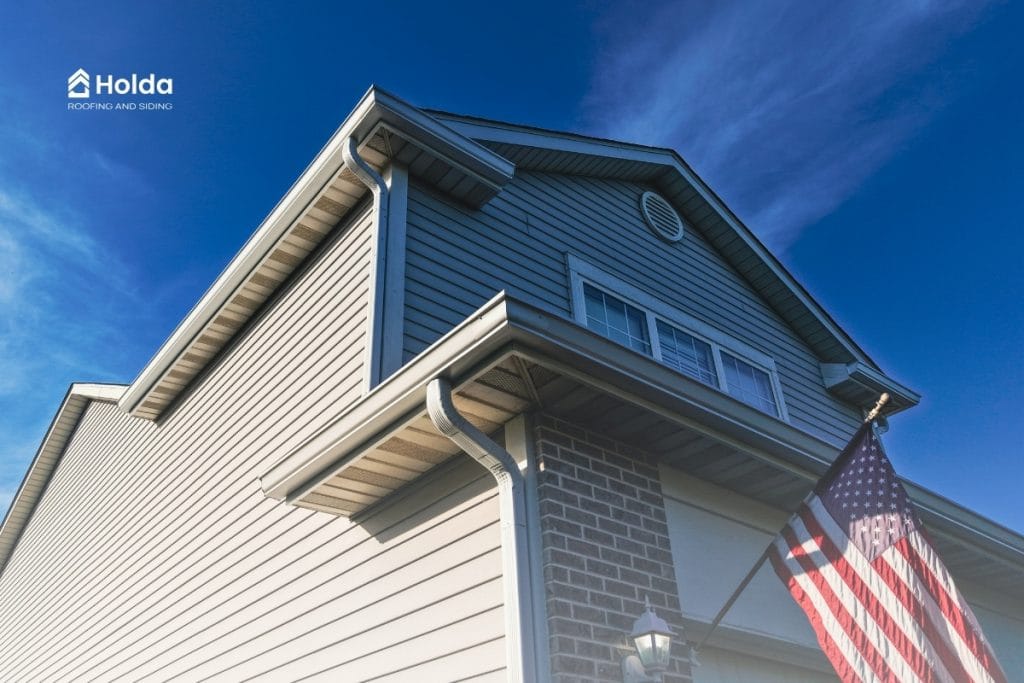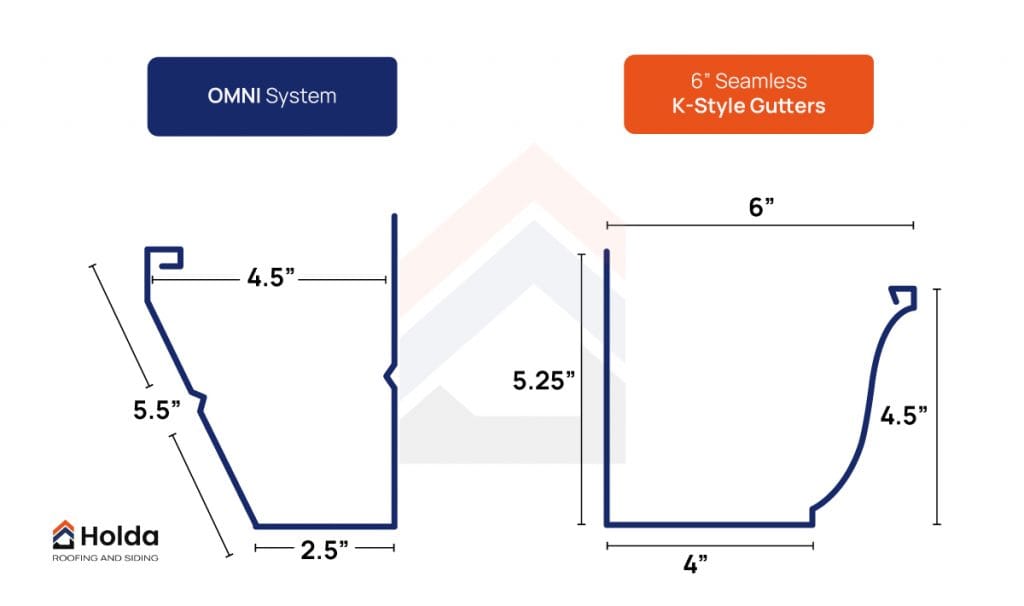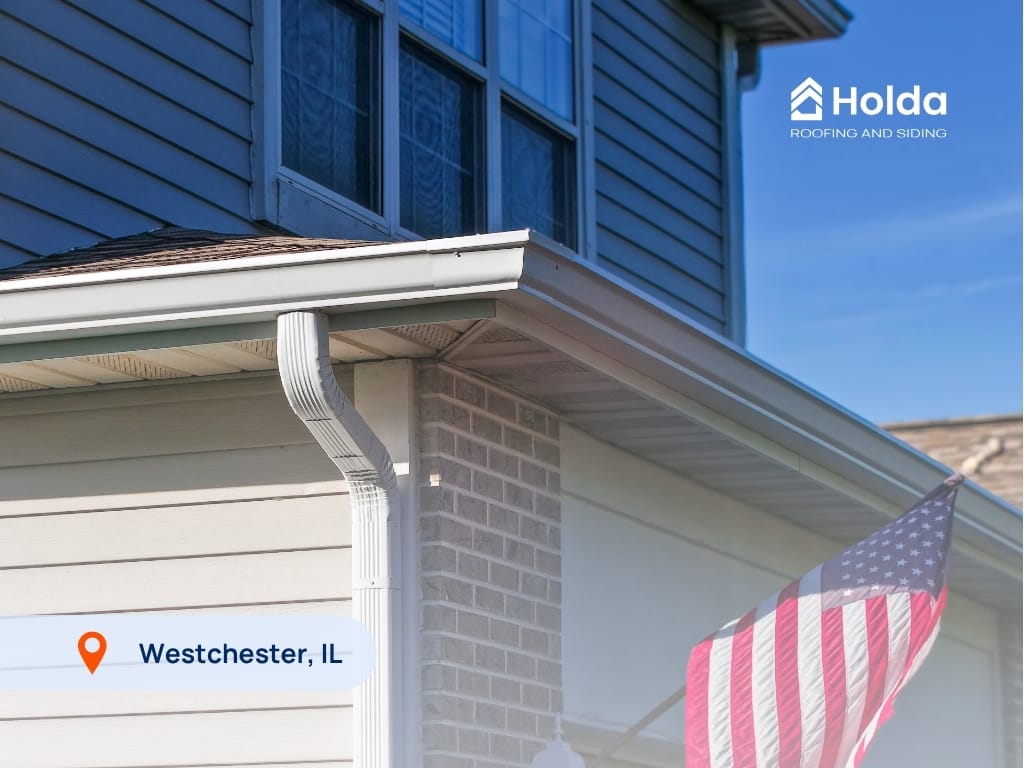IL License Number: 104.017181
IL License Number: 104.017181

If your home was built in Chicago’s Northwest Suburbs between the 1970s and 1990s, chances are it has an Omni (fascia) gutter system—a builder-grade design that blends into the roof trim. While these gutters may have worked fine for decades, many homeowners are now noticing overflow in heavy rains, ice buildup in winter, or sagging along the roofline. As a family-run company with over 25 years of experience, Holda Construction has seen firsthand how these systems age and the risks they pose. This guide explains what Omni gutters are, why they fail in our climate, and how upgrading to a modern gutter system can protect both your home and its curb appeal.
Fascia (Omni) gutters combine the role of the fascia board and the gutter into one deep, flat‑faced aluminum channel fastened directly to roof rafters. The rear of the gutter often includes a channel to receive soffit panels, eliminating separate wood fascia and aluminum wraps. Builders like them because they reduce steps during new construction.

| Feature | Omni Fascia Gutter System (The High-Risk Option) | 6-Inch K-Style Gutter System (The Industry Standard) |
|---|---|---|
| Structural Design | Integrated gutter and fascia mount directly to structural roof rafters, eliminating the protective fascia board. | The gutter attaches to a separate fascia board that acts as a shield, protecting the roof itself from water damage. |
| Primary Failure Risk | Water damage and rot occur directly on the structural rafter ends, leading to expensive repairs. | Water damage and rot are contained by the non-structural fascia board, which acts as a buffer and is simpler to replace. |
| Parts & Repairsk | Extremely difficult. Parts are scarce and dependent on a single, niche manufacturer. Damage often requires a specialist. | Simple and universal. Standardized parts are available at any major hardware store, and any gutter professional can perform repairs. |
| Winter Performance | High risk. Ice dams trap water directly against the roof sheathing and unprotected rafters, creating a direct path for leaks. | Lower risk. The fascia board provides a buffer, as water must first saturate this before reaching the home's structure. |
| Total Cost of Ownership | High. While designed to save builders money initially, the end-of-life replacement is a major construction project, requiring a costly conversion to a standard system. | Low. Standardized parts and competitive labor keep repair and replacement costs predictable and affordable. |
| Resale Value | Negative. Often flagged by home inspectors as an obsolete, high-risk system, potentially lowering home value and complicating a sale. | Positive. A well-maintained, standard system is seen as a valuable feature that protects the home and reflects well on its upkeep. |
We’ve completed 150 townhome unit conversions across the last two summers. Multi‑building sites demand careful sequencing, clean work areas, and consistent quality. Our standard three‑stage workflow looks like this:
Throughout, we verify downspout placements, address corners and transitions, and ensure proper integration with drip edge and soffit for a clean, watertight eave.
Recently, Westchester, IL homeowner Chris Guerrero hired us to replace an aging OMNI (fascia-style) gutter system with a true 6″ seamless K-style setup on her two-story single family home—and the difference was immediate.
We removed the one-piece OMNI, built a straight wood fascia and aluminum wrap base, then installed heavy-gauge K-style gutters with hidden hangers, oversized outlets, and 3×4 downspouts, laser-checking pitch on every run and protecting landscaping throughout.
The $15,000 conversion solved chronic standing water and uneven pitch, sharpened curb appeal, and created a serviceable, long-term system that pairs well with planned trim paint.
Chris put it simply in her 5-star review: “My house looks polished and brand new… the gutters look beautiful. Quality service and a worry-free process.”

A full Omni gutter conversion is more than “new gutters”—it’s a rebuild of the entire fascia system. Costs vary depending on:
While the upfront investment is higher than a basic gutter swap, it’s far less than the expense of repairing rot, attic mold, or foundation damage later. Think of it as a one-time investment that protects your home for decades.
In limited cases we can seal or re‑hang sections, but Omni systems are inherently hard to pitch and to service in small pieces. That’s why full conversion is the long‑term solution.
Yes—for the better. K‑style gutters add a defined trim line. Most homeowners prefer the profile once installed.
During conversion we re‑establish the fascia/soffit connection, preserve airflow, and coordinate with any attic ventilation upgrades when needed.
Most townhome units are completed in a day, with multi‑building sites scheduled to minimize disruption. (Timelines vary by scope and weather.)
You don’t have to live with the unattractive, inefficient fascia gutters your builder used to save money. Holda Construction can upgrade your gutters to a traditional K-style or clog-free system, enhancing both the appearance and functionality of your townhome’s drainage system. Interested in learning more? Contact us at 847.847.2883 or by filling out our online form.
With over twenty years in business and hundreds of satisfied customers, we know what it takes to properly maintain a home. Join the family of satisfied homeowners who trust Holda Construction Roofing and Siding for all their roofing and siding needs.
We look forward to working with you!
Address
317 W Colfax St. Suite 102
Palatine, IL 60067